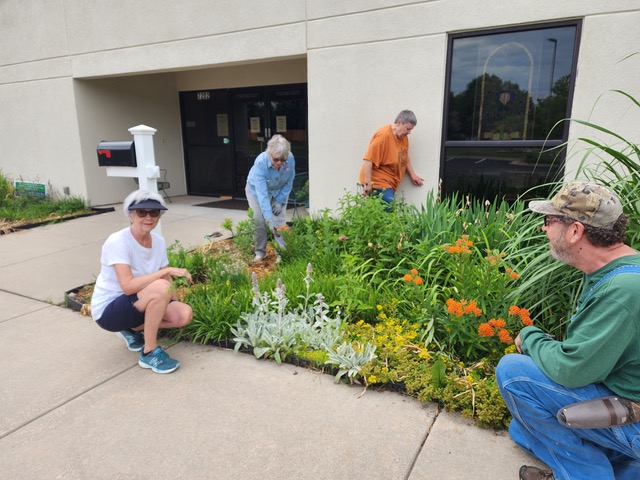When it comes to dealing with droughts in garden beds, Connie Fletcher echoes the advice of Kansas planting experts and other gardeners.
“You want to go more for your native plants because they’re used to the weather here,” said Fletcher, whose home in Valley Center was part of the June garden tour organized annually by the Sedgwick County Extension Office. Her garden was included because it features several plants the extension office called “water-wise plants.”
Fletcher’s watering practice for what she calls her butterfly garden — it’s filled with native plants that attract the butterflies — bears out that description. With a sprinkler system, she waters that area three times a week for three minutes each time. Among the native plants in her yard are bee balm, coneflowers, liatris, Joe Pye weed, daisies and red sage.
Using native plants allows gardeners not only to save water but also money and time because many native plants are perennials, don’t require fertilizer and often create transplants that can fill in other garden spaces. With this type of eco-gardening, gardeners also provide food and shelter to pollinators and wildlife.
It’s not just backyard gardeners who are helping in that effort.
Last year, the Valley Center Public Library opened a native plants pollinator garden just north of the facility. Volunteers planted milkweed, asters and more using a landscape design created by Scott Vogt, the executive director of Dyck Arboretum in Hesston, a 13-acre botanical garden that holds a spring and fall “FloraKansas” sale of native plants.
In Wichita, when members of the First Unitarian Universal Church opened their new building at 7202 E. 21st St. N. in 2008, they created garden beds on either side of the church’s north-side entrance that feature native plants. A more recent garden bed to the east and south sides of the building holds many of the same plants.
Several of the plants in the newer garden were transplants of seedlings from the original garden. Some volunteers who maintain the garden, like Linda Jordan, bring transplants from their home gardens.
On a recent Saturday morning, Jordan and a few other volunteer gardeners pointed out the native plants in the church’s gardens: purple coneflower (also known as echinacea), milkweed, asters, phlox, Russian sage, salvia and more. The gardens also have other flowering plants, like daylilies.
“Wait, I’ll get a trowel to dig a proper hole,” Vivien Minshull-Ford said to Marcia Ellsworth, who had brought a penstemon plant that would help fill a gap between plants near the entrance door.
The church’s gardens were officially declared a Monarch Watch waystation in 2020. Ellsworth helped apply for the certification after reading an article about the important role many of the plants play in creating a natural habitat for monarchs and other pollinators. Monarch Watch is a native Kansas program itself; it was founded in 1992 by University of Kansas professor Orley “Chip” Taylor to promote the monarch butterfly and its habitat in North America and help with the insects’ fall migration.
Native plants can handle whatever weather conditions the Kansas climate throws at them.
They have extensive root systems that help them survive those conditions, including prolonged periods of drought, said Vogt of Dyck Arboretum.
“An example of that would be back in 2011, 2012, when we had those extended periods of 100-degree days even in the fall, we saw native plants blooming in our prairie whereas a lot of other plants were just kind of hanging on,” Vogt said.
Dyck Arboretum, which has an extensive native plant guide that it publishes on its website (dyckarboretum.org) in its FloraKansas event section, defines native as species of “plants that are found in Kansas and its bordering states before European settlement, as well the varieties and cultivars that remain close to the original form and function.” Red and yellow coneflower plants, for example, are cultivars, while purple coneflower is considered more native. Dyck’s native plant guide also lists trees and shrubs.
By allowing the native plants to overwinter, gardeners are also providing habitat and food. For example, finches particularly like eating coneflower seeds during the winter.
Gardeners who want to go native can start doing prep work now for a fall planting, particularly if they are converting a patch of ground filled with grass or weeds, said Vogt. Getting weeds under control before planting is recommended.
Invasive bindweed and Bermuda grass, in particular, need to be removed because their root system is like native plants, “and they will out-compete the native plants,” said Vogt. The best way to get rid of those weeds is to use a chemical spray like Roundup, Vogt said. Some gardeners who resist chemicals often choose to smother the weeds with layers of cardboard and mulch and then slice through the cardboard when planting.
Both Vogt and Fletcher recommend that gardeners get familiar with their site, observing when the area gets sun or shade and for how long, and if it’s exposed to or sheltered from the wind. Then match up the plants that can survive best in those conditions.
Also, familiarize yourself with the bloom times for flowering plants to ensure you get a succession of colors from spring through fall.
Sometimes, it can take up to three years for a native plant to finally take off, so patience is needed, Vogt said.
Contact Amy Geiszler-Jones at algj64@sbcglobal.net.









